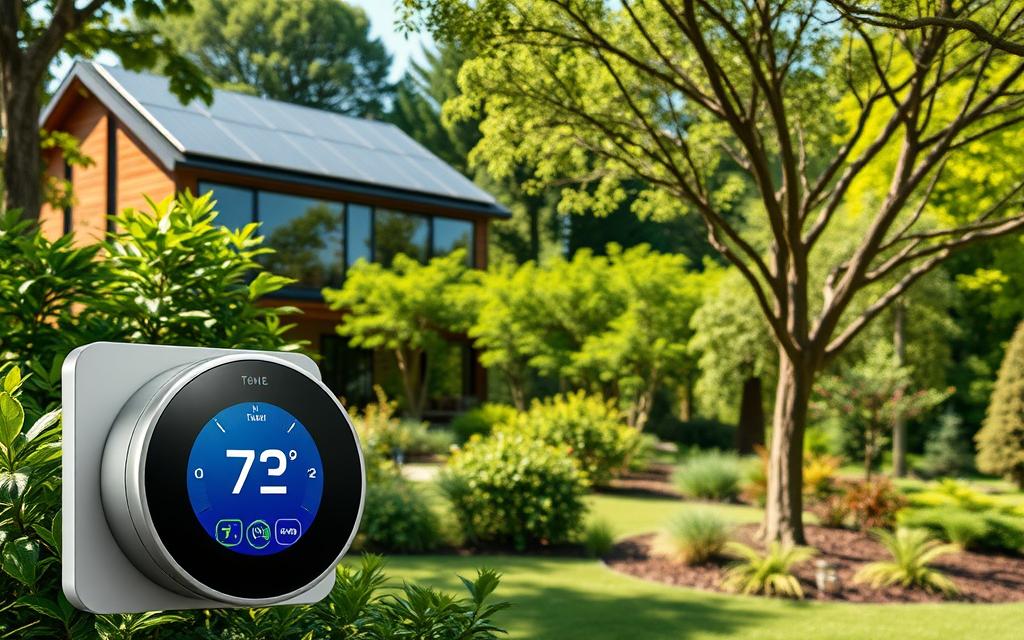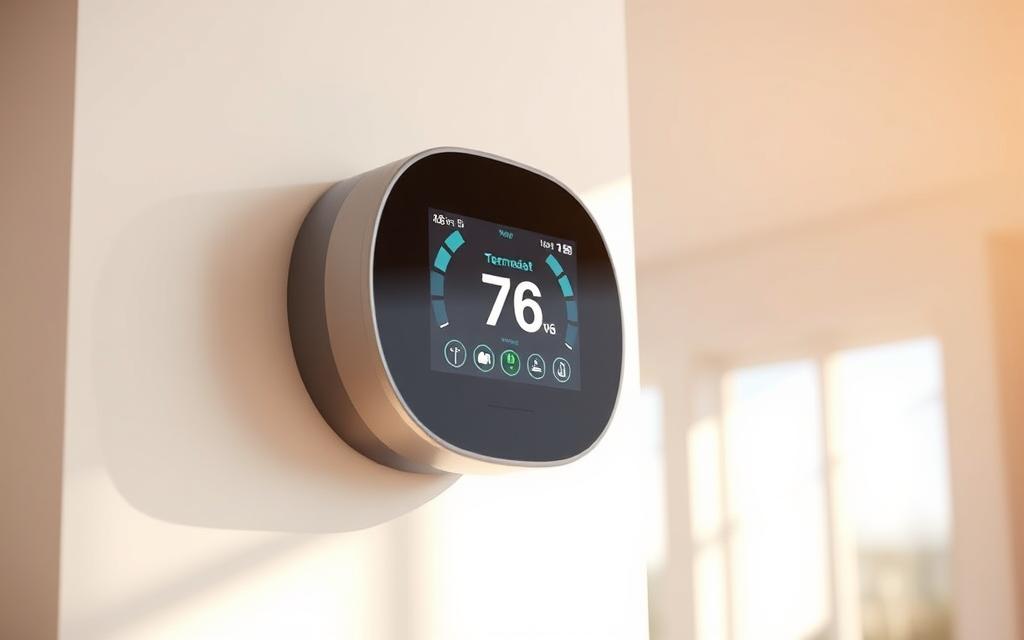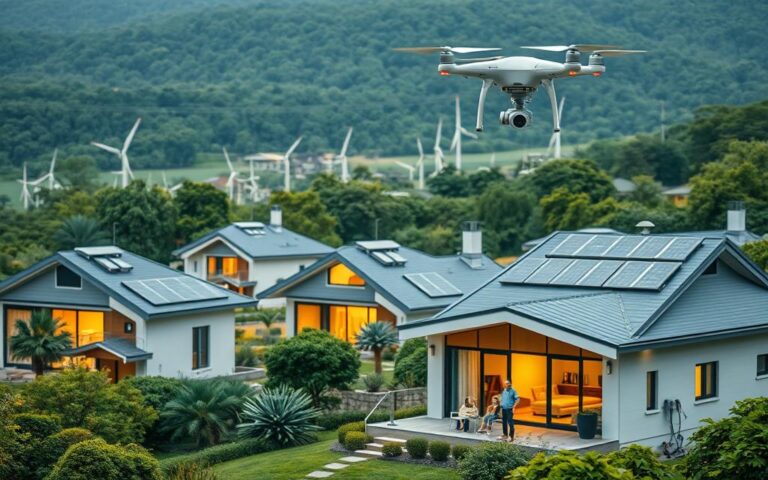Did you know that nearly half of the typical American household’s annual energy bill is over $900? This is spent on heating and cooling. It shows we really need to make our homes more energy-efficient. Smart thermostats are changing how we control our homes’ temperatures.
These smart thermostats are more than just devices. They are key parts of a modern home system, with Wi-Fi to learn your habits. They offer remote control and geofencing to save energy and money. Let’s explore how a smart thermostat can save you money and keep you cozy.
What Are Smart Thermostats?
Smart thermostats are a big step up in home heating and cooling. They are advanced climate control devices that give homeowners better control and efficiency. With Wi-Fi, users can change their home’s temperature from their phones or apps.
Definition and Functionality
A smart thermostat learns what you like and when, adjusting the temperature for you. It’s different from old thermostats because it uses data like who’s home and the weather. This means your home stays comfy without wasting energy.
How They Differ from Traditional Thermostats
Old thermostats need you to change the settings by hand. This can lead to wasted energy. Smart thermostats, on the other hand, can be controlled from afar and learn your habits. This lets them save energy in ways old thermostats can’t.
Benefits of Using Smart Thermostats
Smart thermostats bring many benefits to homeowners. They help make homes more energy-efficient. This is thanks to features that save energy and improve comfort.
Understanding these advantages helps people decide to add smart home technology to their homes.
Energy Efficiency and Cost Savings
Smart thermostats are great for saving energy and money. They use thermostat scheduling to adjust temperatures based on your habits. This cuts down on energy use and lowers your bills.
Features like geofencing learn when you’re home or away. This means they adjust heating and cooling to save energy.
Increased Comfort and Convenience
Smart thermostats make your home more comfortable and convenient. You can change the temperature from your phone, so your home is ready when you arrive. This saves energy and makes your home cozy.
They work well with other smart devices, creating a seamless home environment. This makes it easy to control your home to your liking.
Enhanced Home Automation Integration
Smart thermostats also integrate well with other smart devices. They work together with appliances like air purifiers and humidifiers. This creates a better living space.
By working together, these devices help make your home more energy-efficient. This is good for the environment and your wallet.
Features to Look for in Smart Thermostats
When picking a smart thermostat, look for features that make it easy to use, comfortable, and energy-saving. Smart home tech can make managing your heating and cooling better and more convenient. Here are the key features to think about.
Wi-Fi Connectivity and App Integration
Wi-Fi lets you control your thermostat from anywhere with a simple app. This means you can adjust the temperature whether you’re home or not. Apps also give you energy use reports and alerts, helping you save energy.
Learning Capabilities and Adaptability
Smart thermostats learn your habits to set schedules for you. They analyze your daily routines to save energy without losing comfort. As they learn, they get better at predicting your needs, saving you money on bills.
Voice Control and Smart Home Compatibility
Voice control lets you use your thermostat with Amazon Alexa or Google Assistant. This makes your smart home tech work together smoothly. Choose models that connect well with other smart devices for a full home automation experience.
| Feature | Description |
|---|---|
| Wi-Fi Connectivity | Remote control through an app for easy temperature adjustments. |
| Learning Capabilities | Adapts to user routines for optimal comfort and energy efficiency. |
| Voice Control | Compatible with virtual assistants for hands-free operation. |
| Smart Home Integration | Works with other smart devices for comprehensive automation. |
Popular Smart Thermostat Brands
Homeowners are now embracing smart home technology more than ever. Several brands have emerged as leaders in smart thermostats. Each brand offers unique features to meet different needs, ensuring homes are both efficient and comfortable. Here are three top brands in the market.
Nest Learning Thermostat
The Nest Learning Thermostat is known for its smart design and learning abilities. It adjusts temperatures based on your schedule, learning your preferences. Its modern look fits well in any home, working smoothly with other smart devices.
The app is easy to use, letting you control your thermostat from your phone. This adds a lot of convenience.
Ecobee SmartThermostat
Ecobee SmartThermostat stands out with its built-in room sensors. These sensors help manage temperatures better in larger homes. It works with many smart home systems, offering voice control for hands-free use.
Honeywell Home T9
Honeywell Home T9 is great for those who want performance and value. It’s easy to install and use, supporting remote sensors for different room sizes. It also works well with other smart home tech, giving users more control and customization options.
Installation and Setup Process
Many homeowners wonder if they should install a smart thermostat themselves or hire a pro. If you’re handy, you might think you can do it. But, complex HVAC systems often need a pro’s touch. The right installation is key for your smart thermostat to work well in an energy-saving home.
DIY Installation vs. Professional Help
Installing a smart thermostat yourself can save money on labor. But, you need to be sure you’re comfortable with electrical work. Think about these things:
- Existing HVAC compatibility—Make sure the new thermostat fits with your current system.
- Electrical knowledge—You need to know how to wire it safely.
- Time investment—DIY projects can take longer than you expect.
On the other hand, hiring pros might cost more but gives you peace of mind. They can do the job faster and fix any problems quickly.
Initial Setup and Configuration Steps
After installing the smart thermostat, the setup is easy:
- Download the needed smartphone app.
- Connect the thermostat to your Wi-Fi.
- Enter your location and set your temperature preferences.
- Turn on energy-saving features in the app.
This setup makes your device work better and helps save energy. Adjusting settings carefully can really cut down on energy use over time.
How Smart Thermostats Save Energy
Smart thermostats are key to an energy-efficient home. They use advanced tech to make heating and cooling systems work better. This means they use less energy.
They adjust the temperature based on who’s home. This way, energy is used only when it’s needed.

Adaptive Scheduling Techniques
Smart thermostats have a cool feature called thermostat scheduling. They learn your household’s habits. They figure out when rooms are empty or full.
This info helps them set up schedules that save energy. For example, if no one’s home, they can turn down the heat or AC. This saves a lot of energy.
Remote Temperature Control
Remote temperature control is another big plus. Homeowners can change settings from their phones. This means they can save energy when they’re not home.
If plans change, you can adjust your thermostat quickly. This makes managing energy easier and more effective. It’s perfect for an energy-efficient home.
Troubleshooting Common Issues
Smart thermostats are handy but can have problems. Knowing common issues helps fix them fast. This ensures your home stays comfortable. Issues like connectivity problems and programming errors can slow down your thermostat.
Connectivity Problems
Many users face connectivity issues first. These can be due to weak Wi-Fi or the thermostat’s distance from the router. Here’s how to fix them:
- Check your Wi-Fi signal strength at the thermostat’s location.
- Make sure the thermostat is close to your router.
- Try restarting your router and thermostat to refresh connections.
- Make sure your home network is working right.
Programming Errors
Programming errors happen when settings don’t match your preferences. Simple changes can fix these. Here’s how to handle programming errors:
- Double-check your thermostat settings against your schedule.
- Keep your device software up to date for fixes.
- Reset to factory settings and reprogram as needed.
- Look in the user manual for specific troubleshooting steps.
Cost Considerations for Smart Thermostats
Smart thermostats are a big investment for homeowners. They cost more than regular thermostats at first. But, many think the long-term savings make it worth it. These devices help save energy, making your home more efficient.
Initial Purchase Price
The price for smart thermostats varies from $100 to $300. This can be a barrier for some. Yet, many see the advanced technology as a good deal for saving energy.
Long-Term Energy Savings
Smart thermostats improve comfort and save money over time. They help lower heating and cooling costs. Plus, you might get rebates from your utility company.
Using them regularly can cut your energy bills. This makes the initial cost a smart choice for saving energy.
| Cost Factors | Traditional Thermostat | Smart Thermostat |
|---|---|---|
| Initial Purchase Price | $30 – $100 | $100 – $300 |
| Average Energy Savings per Year | $50 – $100 | $150 – $250 |
| Return on Investment Timeline | Not Applicable | 1 – 3 years |
Making the Switch to Smart Thermostats
Switching to smart thermostats can make your home more energy-efficient and comfortable. First, understand your home’s needs, like HVAC systems and insulation. Researching smart home tech helps pick the right one for you.
Choose ENERGY STAR certified thermostats for better energy use and savings. Make sure your Wi-Fi is strong for your thermostat’s performance. Connecting it to your smart home adds features like remote control and scheduling.
Creating a schedule that fits your daily life is key. Adjusting the thermostat when you’re home or away saves on energy costs. By choosing wisely, you’ll enjoy the benefits of smart home tech fully.



